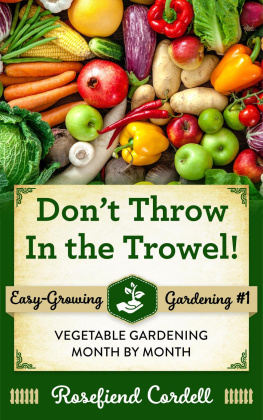VEGETABLE GROWING
MONTH BY MONTH
In the same series
Super Soups & Sauces
Steaming: With Recipes
Uniform with this book
Forget about any glossy pictures, whats in this book is solid words of advice, written in plain-to-understand English from a grower whos had frustrating years of experience behind him in trying to grow nutritious vegetables, whilst at the same time running a business and raising a family. Everyone will benefit from this book and I found the glossary at the back, which explains gardening terminology in a way that everyone will understand, to be extremely useful. It will certainly have a place on my extensive gardening bookshelf.
Medwyn Williams, Chairman of the National Vegetable Society, and member of the Fruit and Vegetable Committee of the Royal Horticultural Society
VEGETABLE GROWING
MONTH BY MONTH

John Harrison


Constable & Robinson Ltd
3 The Lanchesters
162 Fulham Palace Road
London W6 9ER
www.right-way.co.uk
www.constablerobinson.com
This edition published by Right Way,
an imprint of Constable & Robinson, 2008
Copyright John Harrison, 2008
The right of John Harrison to be identified as the author of this work has been asserted by him in accordance with the Copyright, Designs & Patents Act 1988.
All rights reserved. This book is sold subject to the condition that it shall not, by way of trade or otherwise, be lent, re-sold, hired out or otherwise circulated in any form of binding or cover other than that in which it is published and without a similar condition including this condition being imposed on the subsequent purchaser.
A copy of the British Library Cataloguing in Publication Data is available from the British Library
ISBN: 978-0-7160-2189-6
Printed and bound in the EU
1 3 5 7 9 10 8 6 4 2
CONTENTS
INTRODUCTION
It was when I first set up my allotment website that I became aware of how many people were growing their own vegetables for the first time. I realized from the questions being asked on the websites forum that most people nowadays dont have the benefit of following in a parents or grandparents footsteps to guide them, as modern society spreads our family across the country and no longer is growing your own vital to full bellies of a night.
These new vegetable growers were looking for a simple, straightforward guide, written in plain English, that told them what to do, when to do it and how to do it. This is what I have tried to provide here.
Im just an ordinary grower albeit with 30 years of failure and success under my belt so I know the difficulties of holding down a job, raising a family and trying to keep a vegetable plot productive and weed-free.
If there is one trick to this, it is little and often. Just half an hour with a hoe one evening, half an hour sowing and potting up the next evening is far better than planning an entire day in the garden at the weekend when it will invariably decide to rain or the family wants a day out or, worse still, the pressures of the job demand some overtime.
That half hour a day, or better still an hour, becomes your chance to wind down and return to the family refreshed.
If you have children, do try and involve them. The wonder of seeing a seed turn into a plant, and then a crop that finally appears on the plate, is a fantastic cure for the I only eat chips and nuggets disease that is sweeping the nation, its symptoms being obesity and a detachment from the real world in favour of over-developed thumbs pressing the fire button in the latest video game.
That said, do remember that children have shorter attention spans and demand attention themselves. Spend ten minutes teaching them how to hoe and accept that the odd plant is going to be killed by friendly fire. When they get bored, which they will, move onto another job and when theyve had enough of the garden let them go back in. It must be fun if they are to discover the joy of gardening and build a life interest.
Ive tried to answer the main general questions I am asked but one section of the book above all the rest was very difficult to write: the month by month guide. There is no such thing as an absolute set date for a job in gardening. For a start, temperatures vary according to where you are in the country. Winter comes earlier to Scotland than Devon and a drive from north to south in spring will show that clearly, with bare-branched trees changing to buds and leaves as you travel across the land.
I live in Cheshire which is about half way up the country and have based my guide on this. What I cannot guide you through is the weather. We hear of climate change daily in the news and there is no doubt that the weather is becoming more extreme. We cannot say any individual summer or storm is due to climate change but the pattern is definitely changing.
Unfortunately, were not rejoicing in a Mediterranean climate with glorious sunshine. The changes are as likely to bring us a cold wet summer as a drought; winter is less likely to bring a freeze and snow but next year it may. All this means we must adapt to the conditions and be more aware and prepared for the extremes.
So read the month by month guide with an eye on the outside world. Even in the good old days, that were never quite as good as they seem in hindsight, the real skill of the gardener was being able to adapt to the changing weather conditions. It is surprising how often late plantings will catch up and Ive had just as much success, in fact more, with parsnips planted in April rather than February as those old books advised.
You will have failures, thats part of growing. As I write at the end of a summer that has been the wettest recorded and, by general agreement, the worst in memory for the vegetable grower, we still have managed to cover most of our needs.
This year farmers struggled with blight, which thrives and spreads when the weather is warm and damp. Despite a truly awesome chemical weapons array, many lost their potato crop. But I grew the new Hungarian Sarpo variety which is not only resistant to blight but seems to be unpalatable to the slugs, another pest that enjoyed the damp conditions.
These new resistant crops promise the ability to get results without the reliance on chemicals of the previous generation, which is just as well since many are no longer available as stringent safety testing has seen their withdrawal from the amateur armoury. This is no bad thing because a major benefit of growing your own is the certain knowledge that your vegetables are free of poisonous pesticide residues. Thats not to say this is yet another organic growing book, as I do believe there are times where the use of weedkillers and chemical fertilizers make sense but the choice, of course, is yours.
I hope you find this book of value and enjoy it. Of necessity it is only a primer but I hope it encourages and enables you to grow your own.
1
WHY GROW YOUR OWN VEGETABLES?
There are many reasons why people grow their own and Ill try to cover the main ones here. Its difficult to say what will encourage you into home growing but I expect youll find that some of the following apply to you.














